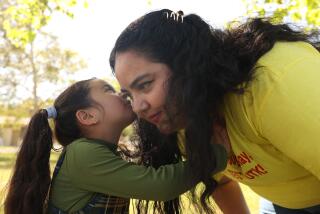Watching Out for Eyes
- Share via
They might know their ABCs, but nearly 1 of every 13 students in the Irvine Unified School District couldn’t read “FZBD4” last year.
That’s the line that measures 20/40 vision on many school eye charts. Those who find it fuzzy fail the state-mandated screening and are referred to eye specialists. They usually end up with glasses--and with hopeful parents and teachers envisioning better school grades in their futures.
That’s because vision problems can be related to a range of learning problems, even to antisocial behavior, school officials and vision-care professionals say. Nationwide, 16% of children 5 through 12 years old have eyesight problems that can hinder learning, according to the American Optometric Assn. in St. Louis.
But while school testing catches the most common vision problems--nearsightedness and astigmatism--many others can be overlooked.
The student who rubs his eyes, complains that reading makes him tired or gives him a headache may have an eye coordination problem that wouldn’t show up on a vision exam based on the Snellen, or “Big E,” chart alone, said Dr. Eric Borsting, coordinator of pediatric disability services at the Southern California College of Optometry in Fullerton.
The child who skips words when she reads may have an eye tracking problem, he said. That’s another condition the test would not catch.
Experts say the most commonly overlooked situation involves the farsighted child who can read the eye chart but struggles with desk-level work.
“A farsighted kid can pass that test easily, and they have more problems in school than nearsighted kids,” Orange optometrist Robert Turner said.
Turner believes those who administer vision tests often fail to check for squinting, which can overcome nearsightedness to the point that children can squint their way through the 20/40 line and pass the test.
In many school districts, among them Irvine Unified and Placentia-Yorba Linda Unified, the vision tests are contracted out to companies often staffed by former school nurses. Students who fail the first test are retested before letters are sent to their homes.
Many school districts coordinate vision screening with required hearing tests. The Placentia-Yorba Linda district, for example, does both screenings in kindergarten, second, fifth, eighth and 10th grades, said Patti Hachiya, supervisor of health services. Of the 10,468 students screened last year, 500 got vision referral letters, Hachiya said.
A member of the Yorba Linda Lions Club, Hachiya works with students who could not otherwise afford glasses. The civic group provided eye exams and glasses for 60 students last year.
Even if a student misses the screening or passes the test, vision problems still can be caught at school if a teacher suspects poor eyesight when a child is having trouble in the classroom.
“If they are having a reading problem, that’s the first thing we check. We want to rule that out before we try another avenue,” said Liana Neuland, who teaches fifth grade at Glenknoll Elementary in the Placentia-Yorba Linda District.
The school has large classrooms, and much of the work in fifth grade is done on the board, she said. “If those in the back are squinting, you can tell right away.”
At that grade level, most students who need glasses already have them. The problem is that they often don’t use them. Sometimes it’s just forgetfulness, but 10- to 13-year-olds especially may be loath to wear their glasses, said Julie Ryan, an Irvine optometrist.
When that is the case, she suggests that parents consider contact lenses or involve the child in selecting the frames for the glasses. For preschoolers, Ryan has found that the prescription must be exactly right and the frames must be fitted properly. Children are more sensitive than adults to minor prescription errors, she said, and youngsters have told her they left their glasses behind on the playground because “it hurts behind the ear.”
The good news for children reluctant to wear glasses is that not all vision problems require them. Some, like eye coordination difficulty, can be handled with therapy in which prisms, lenses and computer programs are used to train the eyes.
At what age should a child have his or her first vision test? The optometric association recommends a screening at six months for major eye problems, followed by exams at 3 years and every two years after that. Some problems, like crossed eyes and “lazy eye,” in which one eye doesn’t see as well, are more easily treated if caught early, optometrists say.
Check the home pages of the American Optometric Assn. and the California Optometric Assn. for more information: https://www.aoanet.org/index-mainspace.htm
https://www.coavision.org/public/public.htm
(BEGIN TEXT OF INFOBOX / INFOGRAPHIC)
Warning Signs
If your child’s nose is literally buried in a book, she could be myopic. Here are some other signs of vision problems that can surface when children read:
* Tired, reddened or sore eyes.
* Headaches.
* Blinking or rubbing the eyes.
* Skipping words and lines.
* Losing place frequently.
* Complaining that words seem to jump or swim around.
* Short attention span.
* Avoiding close work.
Sources: Optometrists Eric Borsting and Julie Ryan; Researched by LYNN O’DELL / For The Times
More to Read
Sign up for Essential California
The most important California stories and recommendations in your inbox every morning.
You may occasionally receive promotional content from the Los Angeles Times.













